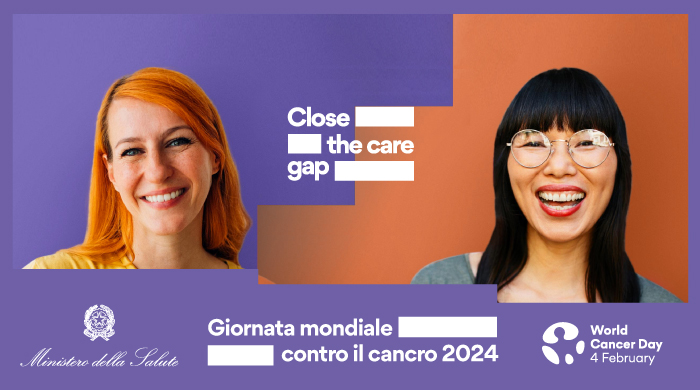Il February 4 If you celebrate the World Cancer Day, World Cancer Day, promoted by UICC – Union for International Cancer Control – and supported by the World Health Organization (WHO).
The Day represents an important reminder to reflect on what institutions and individuals can do together to fight cancer. “Close the Care Gap” (Closing the cure gap) is also the theme at the heart of the 2024 campaign. The slogan draws attention to the importance of understanding and recognizing inequalities in cancer care around the world.
Cancer numbers
In the world
Cancer is a constant disease growth around the world.
In 2022 theInternational Agency for Research on Cancer (IARC) estimates there were 20 million new cases of cancer. The Global Cancer Observatory of the IARC estimates that in 2050 there will be over 35 million new cases of cancer.
L’World Health Organization (WHO) confirms that cancer is the second leading cause of death in the world.
The infographics of World Cancer Day and WHO data indicate that 10 million people died from cancer in 2020.
In Italy
The report “Cancer numbers in Italy 2023” estimates that in 2023in Italy, they will be 395,000 new cases of cancer (with the exception of skin cancers other than melanoma), 208,000 new cases in men and 187,000 in women, with an increase of over 18 thousand cases in 3 years. They were 390,700 (205,000 in men and 185,700 in women) in 2022 and 376,600 (194,700 in men and 181,900 in women) in 2020.
I more frequent tumorsin decreasing order of estimated incidence in the overall population, are:
breast cancer, for which the net survival 5 years after diagnosis is estimated at 88%
colorectal cancer: it is the second most frequent cancer in women and the third in men, survival 5 years after diagnosis in Italy is estimated at 65% in males and 66% in females
lung cancer: it is the second most common cancer in Italian men and third most common in women; survival five years after diagnosis is estimated at 16% in men and 23% in women
prostate cancer: it is the most frequent male tumor, the net survival five years from diagnosis is estimated to be 91%
bladder cancer: net survival five years after diagnosis is estimated to be 80% in men and 78% in women.
Cancers and prevention: preventable risk factors, avoidable deaths
The fight against neoplastic pathologies requires a multi-disciplinary approach and requires coordinated and synergistic interventions at multiple levels, from prevention to improvement of the overall process of taking care of the cancer patient.
From this perspective, in line with the European plan against cancer, both the National Oncology Plan 2020-2027 (Link) and the National prevention plan 2020-2025 (PNP) highlight the importance of prevention and early diagnosis alongside treatment and improving the patient’s quality of life.
Il Aiom-Airtum Report 2023 indicates that about the 40% of new cancer cases and 50% of cancer deaths I am potentially preventable as they are caused by avoidable risk factors, estimates in line with WHO data which indicate the possibility of preventing all cases of cancer between 30-50%.
The main modifiable risk factors they are smoking, poor nutrition, risky and harmful consumption of alcohol, poor physical activity and a sedentary lifestyle.
Nine rules to follow to reduce risk factors
Here are some simple rules to follow based on scientific evidence that can reduce the risk factors of developing some forms of cancer.
Not smoking. Do not consume any form of tobacco. Make your home smoke free. Adopt a healthy and balanced diet Remember that breastfeeding reduces the risk of cancer for mothers Get your children vaccinated against HPV and hepatitis B Avoid excessive exposure to the sun and apply sunscreens before going out Follow workplace health and safety instructions carefully to protect yourself from exposure to carcinogens. Practice physical activity regularly. Avoid or reduce a sedentary lifestyle. Reduce or avoid alcohol consumption. Adhere to oncological screening programs
To know more: WHO infographic
The national oncology plan and NHS screening
Il National oncology plan 2023-2027 is aimed at improving the overall fight against neoplastic pathologies in terms of effectiveness, efficiency, appropriateness, empowerment and satisfaction of patients, and at containing the health and social costs determined by them. Developed according to a global and cross-sectoral approach, with greater integration between prevention, early diagnosis and managementincluding the improvement of care and the prevention of relapses, the Plan places attention on the centrality of the patient and on reduction or elimination of inequalities in access to prevention and treatment interventions.
The Plan is financed through a specific fund with an endowment equal to 10 million euros for each of the years 2023 to 2027.
The programs of screening oncology offered free of charge by the National Health Service reduce cancer mortality because through early diagnosis they allow timely intervention. In Italy, throughout the territory, oncological screenings are offered, with an active call from the health company, to people belonging to age groups considered, on the basis of scientific evidence, to be at greater risk of the onset of the pathology.
The National Health Service offers it for free Effective tests to early identify, combat and limit the consequences of certain types of cancer through 3 screening programs:
cervical screening (PAP test or HPV test) for the prevention of cervical cancer; mammographic screening for early diagnosis of breast cancer; Colorectal screening for the prevention of colorectal cancer.
Cancer screening programs are a Essential Level of Assistance. Adhering to screening means entering an integrated diagnostic-therapeutic path, totally free, which accompanies the person from the screening test to any further investigations and, if necessary, to subsequent care and follow-up treatments.
To know more
